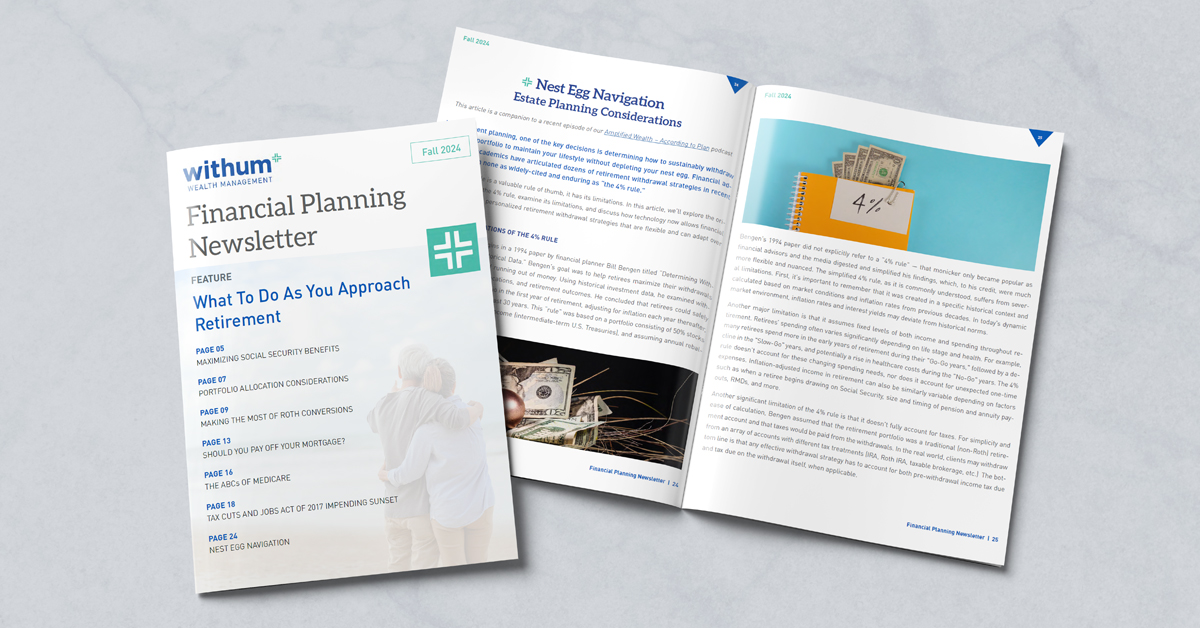Planning for retirement can feel like navigating a maze of tax strategies, with each turn potentially saving – or costing – thousands of dollars. One major change at retirement is the absence of a paycheck. The resulting drop in taxes is often seen as a very welcome change. Alternatively, it can be taken as an opportunity.
A well-planned Roth conversion strategy can take advantage of these low tax brackets while also reducing future tax bills. But like any good play, it’s all about timing and strategy. Let’s dive into how Roth conversions work and why, when done right, they can be a key part of your financial plan.
A Roth conversion involves transferring funds from a traditional retirement account, such as a Traditional IRA or a 401(k), into a Roth IRA. Unlike contributions to a Traditional IRA or 401(k), which are mostly made with pre-tax dollars and taxed upon withdrawal, Roth IRA contributions are made with “after-tax” dollars, allowing withdrawals in retirement to be tax-free, provided certain conditions are met. To put it more simply, pre-tax investments are being converted into post-tax investments, with taxes paid on the funds converted in the year of conversion. Let’s take a closer look at how it works and the potential benefits:
Mechanics of a Roth Conversion
- Conversion Process: To convert, you simply take money from your Traditional IRA or 401(k) and move it to a Roth IRA. The amount converted is treated as taxable income for the year in which the conversion occurs. This means that if you convert $50,000, that $50,000 will be added to your taxable income for that year.
- Tax Implications: When you convert, you’ll owe income tax on the converted amount at your current tax rate. This is because the funds in a Traditional IRA or 401(k) have not yet been taxed. The key is to plan for the tax hit carefully. Ideally, convert in a year when you expect to be in a lower tax bracket or can cover the taxes without dipping into the converted funds.
- Timing: Timing is crucial in a Roth conversion. Many people choose to convert during years when their income is lower, reducing the overall tax impact. For example, many clients have a “window” of several years to do Roth conversions after they retire but before they begin drawing Social Security or are required to take RMDs from pre-tax accounts. Additionally, converting when the market is down can be advantageous since the amount converted would be lower, thus potentially reducing the tax bill.
Why Roth IRA Conversions Are Effective
Roth IRA conversions offer several compelling advantages, making them an attractive option for many savers:
- Tax-Free Withdrawals: The primary benefit of a Roth IRA is that qualified withdrawals are tax-free. This means that once you reach age 59½ and have held the Roth IRA for at least five years, you can withdraw both your contributions and earnings without incurring any taxes. For retirees who anticipate being in a higher tax bracket in the future, paying taxes now at a potentially lower rate can result in significant savings.
- No Required Minimum Distributions (RMDs): Traditional IRAs and 401(k)s are subject to Required Minimum Distributions (RMDs) starting at age 73 (as of 2024). These mandatory withdrawals can push retirees into higher tax brackets. Roth IRAs, on the other hand, do not require RMDs during the account owner’s lifetime, allowing the funds to grow tax-free for a longer period and providing greater flexibility in managing retirement income.
- Estate Planning Benefits: Roth IRAs can also be advantageous from an estate planning perspective. Since Roth IRAs do not have RMDs, account owners can leave their investments to heirs who can then benefit from tax-free withdrawals. This can be particularly beneficial if heirs are in a higher tax bracket or if the account is expected to grow significantly. Due to recent SECURE Act changes, non-spouse heirs must empty inherited IRAs within 10 years, which increases the estate planning benefits of a Roth IRA, especially for heirs in high tax brackets.
- Tax Diversification: Having a mix of taxable, tax-deferred, and tax-free accounts (such as a Roth IRA) can provide greater flexibility in managing your tax liability in retirement. This diversification allows you to strategically withdraw from different accounts based on your tax situation, potentially reducing your overall tax burden.
- Opportunity for Growth: Funds in a Roth IRA can grow tax-free, which can be particularly advantageous during periods of significant market growth. By converting funds, you might position yourself to benefit from this growth without having to worry about future tax implications on the gains.
Considerations and Potential Drawbacks
While Roth conversions can be highly effective, they do have potential drawbacks that should always be considered.
- Upfront Tax Cost: The immediate tax cost of converting can be significant. It’s crucial to have a strategy to cover this cost without impacting your retirement savings. Paying the tax from sources outside the retirement account, such as from personal savings, is generally advised.
- Impact on Financial Aid: For individuals with college-bound children, the increase in taxable income from a conversion could impact financial aid eligibility, as many financial aid formulas consider income from the previous year.
- Conversion Limits: There are no income limits for Roth conversions, but high-income individuals should be mindful of how conversions impact their overall tax situation, especially if it pushes them into a higher tax bracket.
- Charitable Intentions: If charitable gifts are intended, it is better to make them from a pre-tax retirement account than from a Roth account.
In summary, a well-timed Roth conversion can be a powerful tool in your financial planning toolkit, offering tax-free growth, flexibility in retirement, and potential estate planning benefits. However, every situation is unique, and the upfront tax cost requires careful consideration. Working closely with your financial advisor and CPA can help you determine the best approach, ensuring that a Roth conversion aligns with your long-term goals and maximizes the potential for tax savings.



